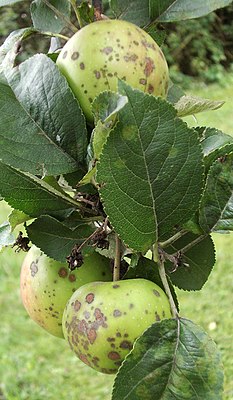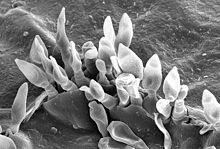Venturia
| Venturia | ||||||||||||
|---|---|---|---|---|---|---|---|---|---|---|---|---|

Apple scab ( Venturia inaequalis ) |
||||||||||||
| Systematics | ||||||||||||
|
||||||||||||
| Scientific name | ||||||||||||
| Venturia | ||||||||||||
| Sacc. |
Venturia is a genus of Ascomycetes (Ascomycota) from the order pleosporales . The fungi cause diseases in fruit and other deciduous trees called scabs .
features
Macroscopic features
The fruiting bodies are embedded in the host tissue and form a scaly appearance on the surface.
Microscopic features
The small fruiting bodies consist of perithecia-like pseudothecia , which can be developed individually or in groups, and which have a tiny, superficial, wart-shaped opening, the ostiolum. The ostiolum can rarely be provided with bristles. The cell walls of the fruiting body are made up of brown, thick-walled cells, the pseudoparenchyma , but the inner cell walls are hyaline and thin-walled. In the center of the fruiting body there are filamentous, branched and septate pseudoparaphyses . The asci are bitunicate , that is, two-layered, cylindrical or elongated, short-stalked and always with eight spores . These are elongated, elliptical, club-shaped or spindle-shaped from olive-green to pale or dark brown in color. They can be smooth or warty or slightly prickly, sometimes with a thin gelatinous coating. They are septate below or above the middle, sometimes a little constricted there.
The secondary crop forms are assigned to Fuscladium , Cladosporium , Pollaccia and Spilocaea . In Fusicladium , the mycelium is embedded and often has a stroma . The conidiophores are single or once branched and usually arranged in tufts. The conidia are solitary or in short chains and often spindle-shaped. They are 0-3x septate, pale to olive brown and fine black. In Cladosporium , the colonies are fluffy, flaky, and only sometimes with a stroma. The conidiophores are straight or curved, mostly unbranched. The conidia are arranged in chains, simple, cylindrical to oblong, but also spherical, often with a notch at the base. They are smooth, warty or prickly and 0-3x septate.
If the minor crop form is Pollaccia , irregularly distributed, sometimes confluent, sporodochia are formed. A stroma is formed in or under the epidermis . The conidiophores are simple, smooth, compressed, hyaline to olive green. The conidia are solitary, cylindrical or elliptical, obtuse at the base and rounded at the tip. They are hyaline or olive-colored, smooth or warty, 1-2x septate. As a fourth form, Spilocaea can be formed. Here the mycelium is in the tissue and forms round discs. There is usually a stroma. The conidiophores are usually simple, straight or curved, brown and smooth. The conidia are single, mostly pear-shaped to club-shaped. They are pale to olive brown, un- or simply septate, rarely more, sometimes constricted at the septum.
Ecology and importance
The species all live parasitically on living plant tissue , mostly on the leaves. Some species then form fruiting bodies on overwintered leaves.
Since several species are found on fruit trees, they are of particular economic importance. This is especially the Pfirsichschorf ( Venturia carpophila ), in addition to peaches and nectarines, apricots infests plums and almonds, the Kirschenschorf ( Venturia cerasi ), the apple scab ( Venturia inaequalis ) and the Birnenschorf ( Venturia pyrina ).
Spread and control
The fungi themselves overwinter on the fallen leaves as ascospores (winter spores), which are thrown up when it rains in the spring and, if the rain period is long enough, attack leaves or fruits, whereby they only penetrate the cuticle . The maximum of the spore flight often coincides with the flowering of the fruit crops. In summer, conidia (summer spores ) form on the infected areas .
The raking or raking of the fallen leaves and their professional composting serves to protect against excessive infestation. However, this measure can only be carried out in an allotment garden. Commercial cultivation continues to protect the trees through the application of pesticides based on a warning service (scab forecast) at a specific time. A biological fungicide suitable for the species of pome fruit is the bacterium Bacillus subtilis , strain QST 713.
Surname
The name honors the Italian bryologist Gustavo Venturi .
Taxonomy
Species of the genus Fusicladium are counted to Venturia , since the former form the secondary fruit form , the latter form the main fruit form. Some species of Cladosporium , Pollaccia and Spilocaea also form secondary crop forms of Venturia . The type species is Venturia inaequalis . The genus contains 57 species:
- Venturia acerina
- Venturia aceris
- Venturia adusta
- Venturia anemones
- Venturia asperata
- Venturia atriseda
- Venturia aucupariae
- Peach scab ( Venturia carpophila )
- Venturia centaureae
- Venturia cephalariae
- Cherry scab ( Venturia cerasi )
- Venturia chamaemori
- Venturia chlorospora
- Venturia comari
- Venturia crataegii
- Venturia ditricha
- Venturia epilobii
- Venturia eres
- Venturia fraxini
- Venturia geranii
- Venturia helvetica
- Venturia hystrioides
- Apple scab ( Venturia inaequalis )
- Venturia integra
- Venturia juncaginearum
- Venturia kunzei
- Venturia lonicerae
- Venturia macularis , on poplar
- Venturia maculiformis
- Venturia mandshurica
- Venturia minuta
- Venturia nashicola
- Venturia nitida
- Venturia palustris
- Venturia polygoni-vivipari
- Poplar scab ( Venturia populina )
- Venturia potentillae
- Venturia pyrina
- Venturia ribis
- Venturia rumicis
- Willow scab ( Venturia saliciperda )
- Venturia subcutanea
- Venturia thwaitesii
- Venturia viennotii
Individual evidence
- ^ A b c Richard T. Hanlin: Illustrated genera of Ascomycetes. Ed .: The American Phytopathological Society. tape 2 . APS Press, 1990, ISBN 978-0-89054-107-4 , pp. 164 ( accessed from mycobank on May 29, 2015 ).
- ↑ a b c d e A. Sivanesan: The Bitunicate Ascomycetes and their anamorphs. Lubrecht & Cramer Ltd, 1984, ISBN 978-3-7682-1329-5 , pp. 701 ( accessed from mycobank on May 29, 2015 ).
- ↑ a b Scab diseases. ( Memento of the original from September 3, 2013 in the Internet Archive ) Info: The archive link was inserted automatically and has not yet been checked. Please check the original and archive link according to the instructions and then remove this notice. (PDF; 263 kB) DEGA, 35/2004.
- ↑ Adalbert Griegel: My common orchard. Large disease and pest calendar. Griegel, 2001. p. 98.
- ^ Horst Börner: Plant diseases and plant protection. 8th edition. Springer, Heidelberg et al. 2009, ISBN 3-540-49067-1 . P. 442.
- ↑ BHL Taxonomic literature: a selective guide to botanical publications
- ↑ Andreas Beck, Anja Ritschel, Konstanze Schubert, Uwe Braun, Dagmar Triebel: Phylogenetic relationships of the anamorphic genus Fusicladium s. lat. as inferred by ITS nrDNA data. In: Mycological Progress . tape 4 , no. 2 , 2005, p. 111-116 , doi : 10.1007 / s11557-006-0114-8 .
- ↑ Kirk PM, Cannon PF, Minter DW, Stalpers JA .: Dictionary of the Fungi. 10th edition. CABI, Wallingford, UK 2008, ISBN 978-0-85199-826-8 , pp. 722 ( accessed from Google Books on May 29, 2015 ).

